Last updated: April 7, 2025
Article
Cultural Landscapes: The Development of a National Park Service Perspective
National Center for Preservation Technology and Training
This presentation, transcript, and video are of the Texas Cultural Landscape Symposium, February 23-26, Waco, TX. Watch a non-audio described version of this presentation on YouTube.
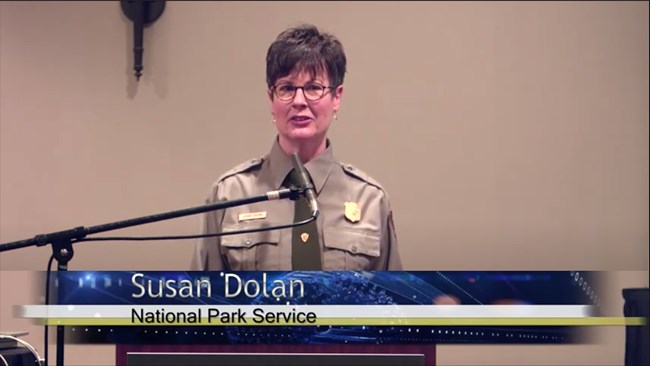
National Park Service
Susan Dolan: How lovely to be back. Thank you and pleasure to have the opportunity to talk about the National Park Service perspective on cultural landscapes.
First of all, just a little framing of what I'm going to talk about, and that is cultural landscapes has a very specific meaning for the National Park Service. It's a meaning that's also shared by some of the federal agencies and some state and local groups too. The National Park Service has inscribed in policy, a very narrow definition of what cultural landscapes are, and really, this comes from the need to be able to justify the expenditure of public funds in a way that's not arbitrary and capricious, that we all agree on.
Rather than the broad definition of cultural landscapes that's really used throughout the world of any land shaped by people, the National Park Services’ definition is a very small piece of the pie, and that is that these are geographic areas, eligible for listing on the National Register of Historic Places as sites or districts. In other words, these are areas with historic significance and areas with historic integrity or authenticity. We use, very much, the National Register definition to constrain what we mean by cultural landscapes.
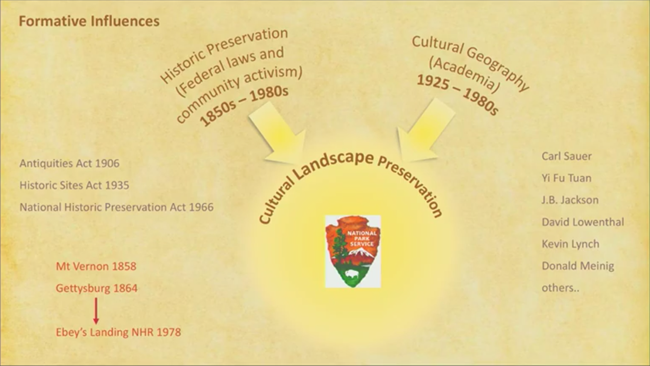
Susan Dolan, National Park Service
I'm going to talk about the evolution of cultural landscapes, the concepts, the program and the National Park Service. Starting with the 1980s, we have early concepts. In the 1990s, codification and professionalization. In the early 2000s, we really focus very much on research and planning. Here in the teens really moving on to the 2020s, we're now very much focused on stewardship, the on the ground operation.
Starting out with the 1980s and early concepts, and most of this is going to be very familiar now to you all after what you heard yesterday. The cultural landscape preservation in the National Park system really came out of two influences; the influence of historic preservation laws and community activism that really very much stimulated the passage of enactment of these laws, and then from cultural geography, which was really a manifestation of academia. On the historic preservation laws side, we've got the legislation that was passed starting from 1906 through the big one of course being '66, and Nancy will talk about the National Historic Preservation Act, it was very much a backbone foundation of the cultural landscapes program. We also had a whole community of cultural geographers that influenced our thinking about land and systems and the interaction of culture with them. We very much grew out of both of these trajectories in forming our program.
Among those culture geographers is Carl Sauer, who worked at UC Berkeley and is really considered the Father of Cultural Geography in the United States. Carl said, "The cultural landscape is fashioned from the natural landscape by a cultural group. Culture is the agent, the natural area is the medium, and cultural landscape is the result." He said that in 1925, much, much long before the National Park Service coined the term cultural landscapes, which was really not until the 1980s.
In the 1980s, we are very much concerned with the concept of integrity and how to apply it to cultural landscapes, and also to gain recognition for cultural landscapes as a type of historic property. I'd like to dwell a little moment on the contribution of Robert Melnick, not to embarrass him, but to truly give credit where it's due. We had this legislation, we had the cultural geographers, we had the National Park Service suddenly aware and concerned with battlefields and some historic grounds of buildings at the time, but Robert Melnick came along at just the right time when people in the service and people in the community were saying, "Landscapes are dynamic, so of course they can't have integrity. They don't fit the National Register criteria, and historic structures are really where it's at. These are the things that are the most important. These are the macroscopic megafauna of place."
Robert listened to this and he also listened to this from Dick Sellars. Richard Sellars, a wonderful historian for the National Park Service who said to him once, "Working with cultural landscapes was like trying to nail Jello to the wall." Robert responded by nailing jello to the wall. Robert's influence, his work for the National Park Service in the 1980s, took us from thinking about cultural landscapes in terms of a plum pudding into a lattice. I'll talk more about that in a sec.
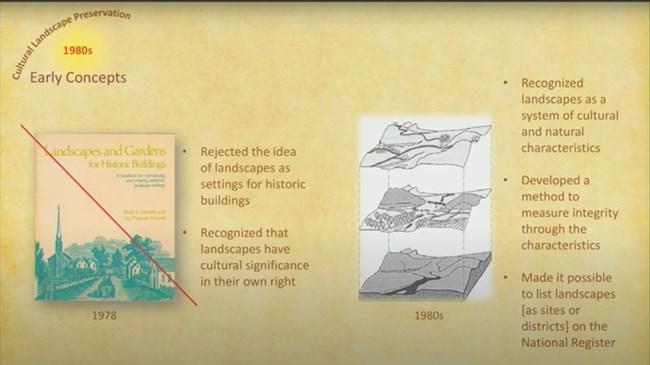
Susan Dolan, National Park Service
Before, really, Robert Melnick came along and blew out our thinking about cultural landscapes, the National Park Service very much treated places as a plum pudding, where they had a series of individual features, isolated features on land that would have, by the way, the National Register boundary drawn very, very exactly around them, no buffer would be included. With almost a vacancy in between them that didn't really matter too much, maybe it would be mown turf, but the character of this area was not so important. Well, Melnick's work really took us into this lattice, three-dimensional lattice way of thinking about historic places, where we have a interwoven web of landscape characteristics that are all important to conveying the character and significance of this place.
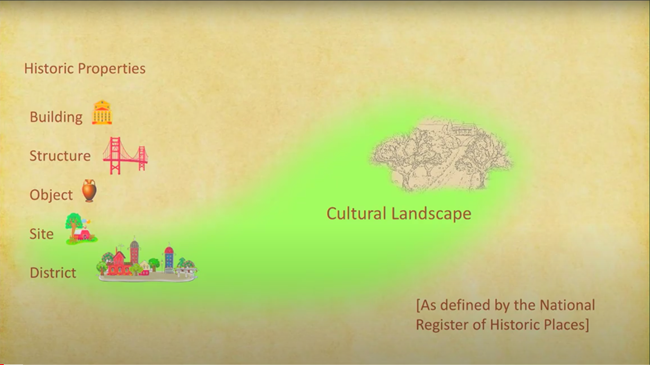
Susan Dolan, National Park Service
Robert did this by taking on a project in the early 1980s about the analysis and evaluation of rural cultural landscapes and how they fit with the National Register criteria. He did this work with a group of students, and as Julie and others mentioned yesterday, this was done at Boxley Valley within the Buffalo River National Recreation Area.
As a result of this work, Robert influenced us to reject the idea that landscapes were just the settings for historic buildings, just the repository that a building is located within. This book is evocative of the thinking of that time that Robert was reacting against. This 1978 book is Landscapes and Gardens for Historic Buildings. We take a building and we fashion a landscape to suit the building. He really rejected that and said that, "Recognize that landscapes have cultural significance in their own right." He recognized landscapes as a system of cultural and natural characteristics, and he developed a method to measure the integrity through these characteristics as we talked yesterday. He made it possible to list landscapes as sites or districts on the National Register. That really took us a tremendous long way in terms of academic thought and philosophy. It took us a little while to catch up in terms of codification and procedure.
In terms of the National Register world of historic properties that can be listed, we have five types of historic property, buildings, structures, objects, sites and districts. Robert's work firmly helped us see that cultural landscapes would be listed on the register as sites or districts, and really should have a slide about sites or districts because I find this quite useful. We went through a period in the Obama administration of feeling like we could and should modify the law of the National Historic Preservation Act to add cultural landscape as a sixth property type. We thought, "Oh, we need this, we need this, it'll help us get landscapes on the register, it will help us raise awareness." In fact, that wasn't politically possible and thank goodness we didn't try and open up the Act in order to amend it to add landscapes.
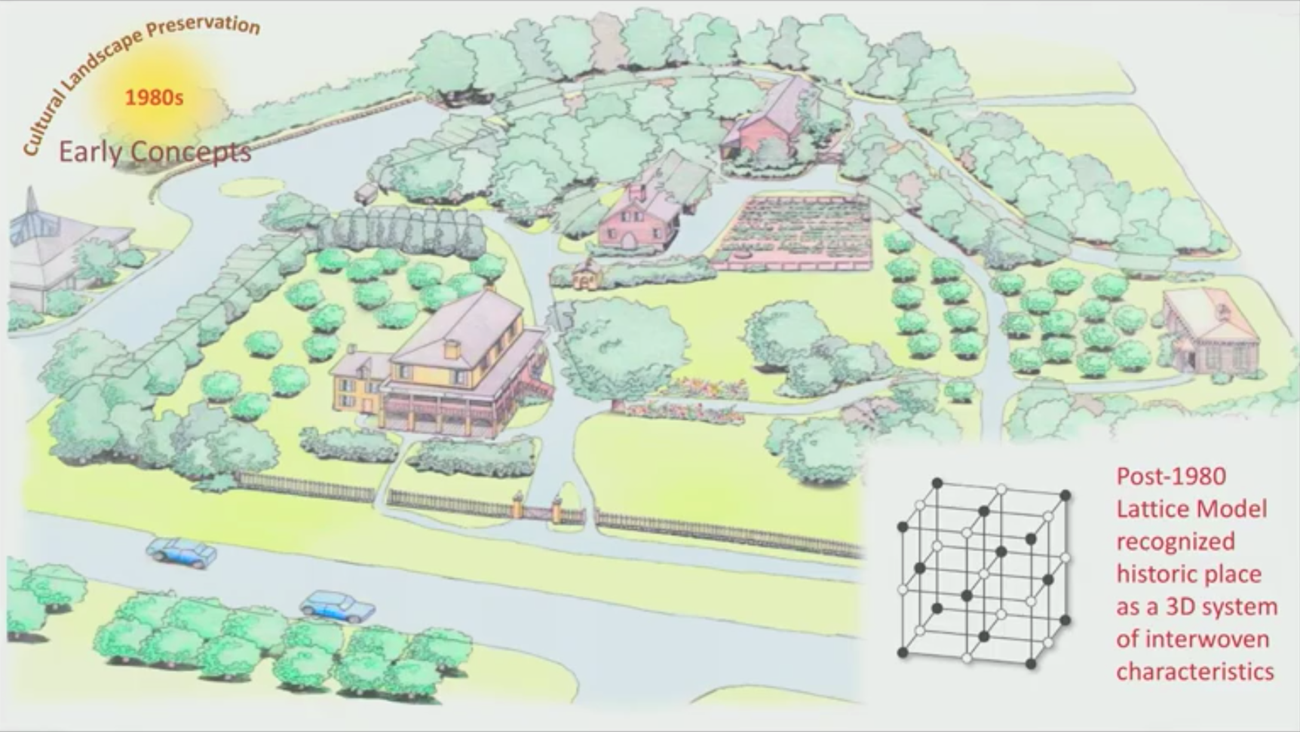
Susan Dolan, National Park Service
Sites or districts, they are good enough for us, I believe, after thinking about it for a long time. Sites are a singular concentration of stuff, singular locus of stuff. Any landscape that has of singular locus would go on the register as a site. Any place that had multiple loci, multiple aggregates of things with interconnections, physical interconnections between them that were historically significant, this goes on the register as a district. Why I feel fine about it being this way for landscapes is that, this is the way archaeology goes on the register. It goes on the register as sites or districts, and some of you know depending whether this is a singular locus or multiple loci connected. So, its fair for archaeology can be fair for landscapes, and really, it's a question of education and awareness raising that cultural landscapes go and register as sites or districts.
This early work in the 1980s applied the concept of integrity to landscapes, gained recognition for landscapes, and helped the National Park Service begin to recognize vernacular landscapes, those that were laid out according to function rather than design, the ordinary places where life happens in America rather than just design landscapes and battlefields. Recognizing the Boxley Valley, recognizing Ebey's Landing National Historical Reserve in Washington, the significance in these vernacular landscapes rather than more of the high style design of the President Adams' home in Quincy, Massachusetts or the civil war battlefield of Antietam, both of these we were already comfortable with before Robert came along.
Moving into the 1990s, we move into codification and professionalization, where we're going to adopt the philosophical and academic work that Robert has given us and turn it into principle. Out of this era, and certainly much inspired by the work that Robert did, we have National Register Bulletin 30 about nominating rural landscapes to the National Register. We also have the guidelines for the treatment of cultural landscapes. We have a document to guide the contents of a cultural landscape report , and we have protocol for doing cultural landscape inventories. All of this work really came out of a community of professionals working inside the park service and outside the service. Robert was certainly in the thick of all of this that helped us to take these thoughts and formalize them in protocol. This is, of course, an essential step. I want to recognize all of these people, but certainly there are others that aren't represented here. It took a community of people working together to make this happen.
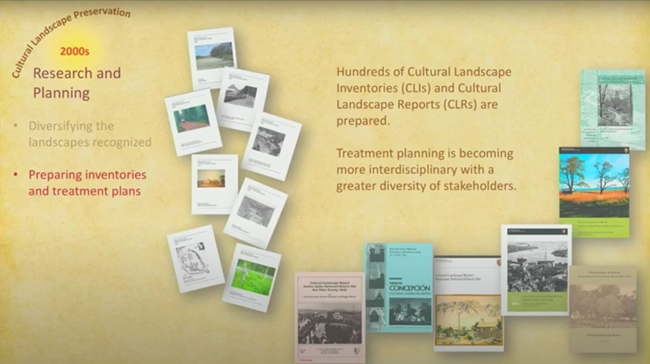
Susan Dolan, National Park Service
The Bulletin 30 for nominating rural landscapes, the National Register, came out in 1990. It was a close companion to Bulletin 18 that came out in 1987 for nominating designed landscapes in the National Register, and Robert had a hand in both of these. This provided us guidance for recognizing and nominating vernacular landscapes, the National Register and it augmented, this one augmented existing guidance for designed landscapes. This is the early 1990s.
We also had the Secretary of the Interior Standards for the Treatment of Historic Properties become adapted with Guidelines for the Treatment of Cultural Landscapes in 1996, that really applied the concepts of treatment to cultural landscapes. Lauren Meyer, one of the people that was in the former side, one of the early founders, did these drawings to help us see one landscape, how it would be altered by restoration versus rehabilitation, so that we clarify what these concepts would mean for a landscape.
The cultural landscape report really got defined in the 1990s as the blueprint vision for the future of landscape. We understand what's precious to preserve and how we want to plan ahead, what should we do with it now on the ground. That's a cultural landscape report and the Guide to Cultural Landscape Reports formalized the contents, so there'll be some standardization across the National Park Service.
This is the Cultural Landscapes Inventory Professional Procedures Guide, that internal guide for National Park Service staff on how to do a cultural landscape inventory . That also came out of the 1990s. The cultural landscape inventory is a stocktaking of a landscape. It's identifying what's precious to preserve. It's what a National Park Service manager references say, "This is what I've got on the ground that I need to take care of." This is what we call our Section 110 documentation, and this was our guide how to do that inventory on the ground. Again, coming out of the 1990s. We also had some scholarship that particularly emphasized the history of the National Park Services’ design and planning and recognize the historic significance of this work in the history of park planning and design in the United States. As a result of this work, we really started to value more the early interwar, first to second world war design period master planning and construction on the parks and helped us look at these places in the national parks as cultural landscapes.
Moving on to the 2000s. Research and planning, I'm calling this era as the major emphasis. In the 2000s, scholarship raised awareness of the historic significance of other types of cultural landscapes, other types including orchards and modern landscape architecture was something that came out of the 2000s. We started to understand other landscape contexts, other types of landscapes and broadening happened during this time. This was also the time in which hundreds of cultural landscape inventories (CLI) and cultural landscape reports (CLR) are prepared. Ordinarily, we do a CLI before we do a CLR. The CLI is what you've got that's precious to preserve and the CLR is that look ahead, that vision for the future. It usually happens after you've already figured out what's precious to preserve. We really, really got cracking in doing tons and tons of inventories, and we attempt to do a cultural landscape inventory for every cultural landscape in the National Park System. That is our goal.
We do the inventory on landscapes that we think are potential cultural landscapes in order to determine that they are, in fact, cultural landscapes. As a result of doing the CLI and sharing it with the state historic preservation office, we get a thumbs up or not, whether that place is eligible as a site or a district. This is what really definitively turns a landscape, a potential cultural landscape into a cultural landscape doing the CLI. Then, all of these CLRs are done generally after the CLI to look ahead and make a plan for the future on the ground. During this period of time, treatment planning becomes more interdisciplinary with a greater diversity of stakeholders recognized to be part of the process.
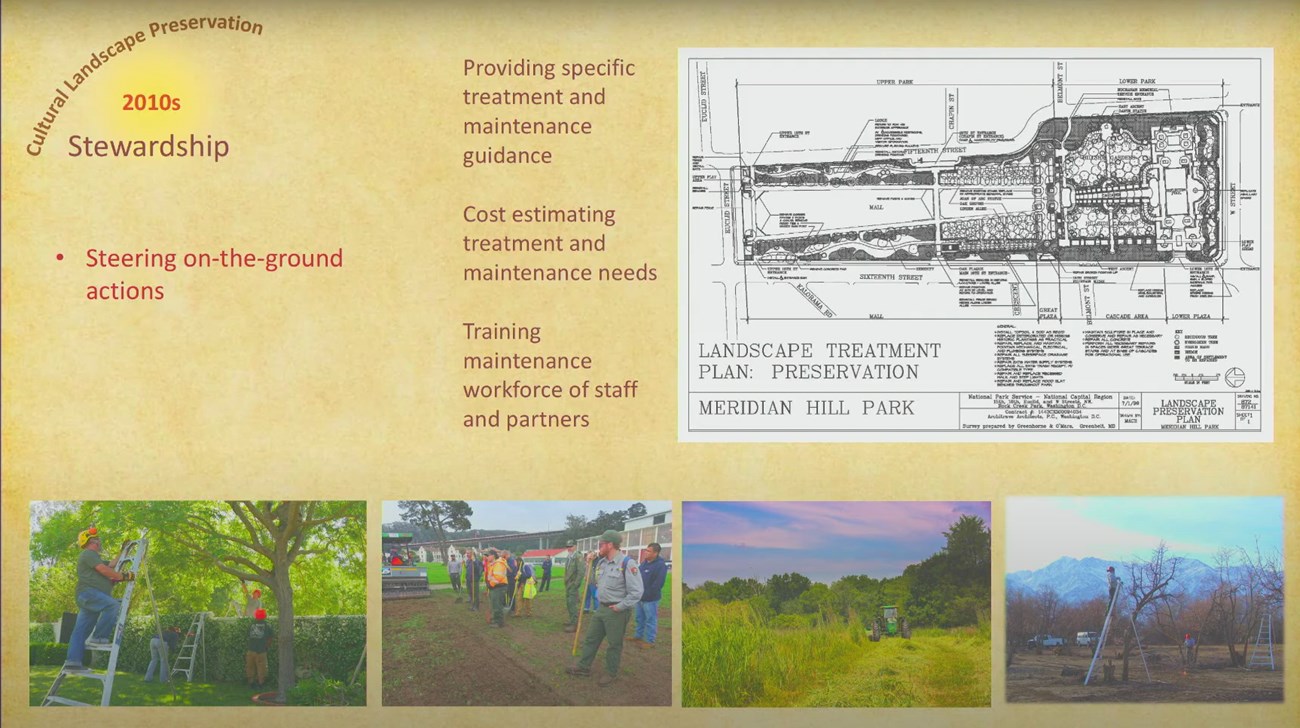
Susan Dolan, National Park Service
For example, at Washita Battlefield National Historic Site in Oklahoma, the treatment objectives for the cultural landscape aim to restore the tall grass prairie that existed at the time of the battle in 1868 and this came out of 2003. Rather like the work that Rolando was talking about yesterday at Palo Alto restoring the Gulf Cordgrass community, this work was happening at Washita starting also in the early 2000s. That really brought a broader view of place such that natural and cultural resource values would be combined in treatment objectives, understanding that cultural landscapes are both cultural and natural, and that we can get multiple values satisfied from their preservation. This idea is very much rooted in the work from the 2000s.
Looking on to the 2010s, I'm labeling this era stewardship. We started to move beyond planning and preparing cultural landscape reports to what do we do now physically on the ground. Actually, I should say that I'm going to talk a little bit about steering on the ground action. The cultural landscapes program is now more involved than ever in steering on the ground actions in national parks and also intersecting with multiple stakeholders, but also acknowledging our constraints and opportunities. I would say that that is very much a reality of where we are today.
As part of the work of steering on the ground actions, we realized that we needed to get quite specific in treatment and maintenance guidance, that it wasn't possible just to bubble out zones in a treatment plan of restore here, rehabilitate here, or this area should feel like this and this area should feel like this. This work wasn't going to go anywhere other than someone's bookshelf in their office unless we really iterated what did that look like physically manifest that character, what vegetation communities, what sort of density, where would this go, where would this go, what size of trees, what type of paving, etc., much more specific. Also, with that, what parks need is our help in cost estimating these treatment and maintenance needs.
I've been with the service for 23 years, but I began this role in 2011. I knew when I began this role that I wanted to try and move the service from research and planning in cultural landscapes to stewardship because I sensed that there was a gulch between those that would prepare the plans and those that got their fingers dirty on the ground, and that our translation really need to be made.
In addition to that, we also needed to step up and do more training of our workforce. Lauren [Meyer] said [it wonderfully yesterday] that the more skilled we are, the more capacity we have to preserve cultural landscapes. A reality for us is that a lot of people don't come equipped with the skills to work and cultivate and care for things on the ground and that we've all gotten too far away from the work that gets the dirt under our fingernails, and I think that that work needs to be more honored and elevated and people that do the work on the ground need to be more honored and elevated. That's such a personal mission of mine to really focus on the professionalization and the skills of the people that do the work on the ground.
This gives you an example of how we needed get more specific. To steer on the ground actions, what type of turf is appropriate for a particular cultural landscape? In the older cultural landscape reports, we might have a zone indicated as turf on the treatment plan, but unless you specify you are leaving it to the interpretation of a maintenance staff and their skillset, their experience to know whether it should look like lawn, which you are more likely to get instinctively if you're in the Midwest of the country because that's more of a cultural norm there, versus a very sort of shaggy, long turf, which are more likely to get in the Pacific Northwest where the attitude is more like just let it be, it's all groovy. We need to give more specificity to the type of turf we're talking about.
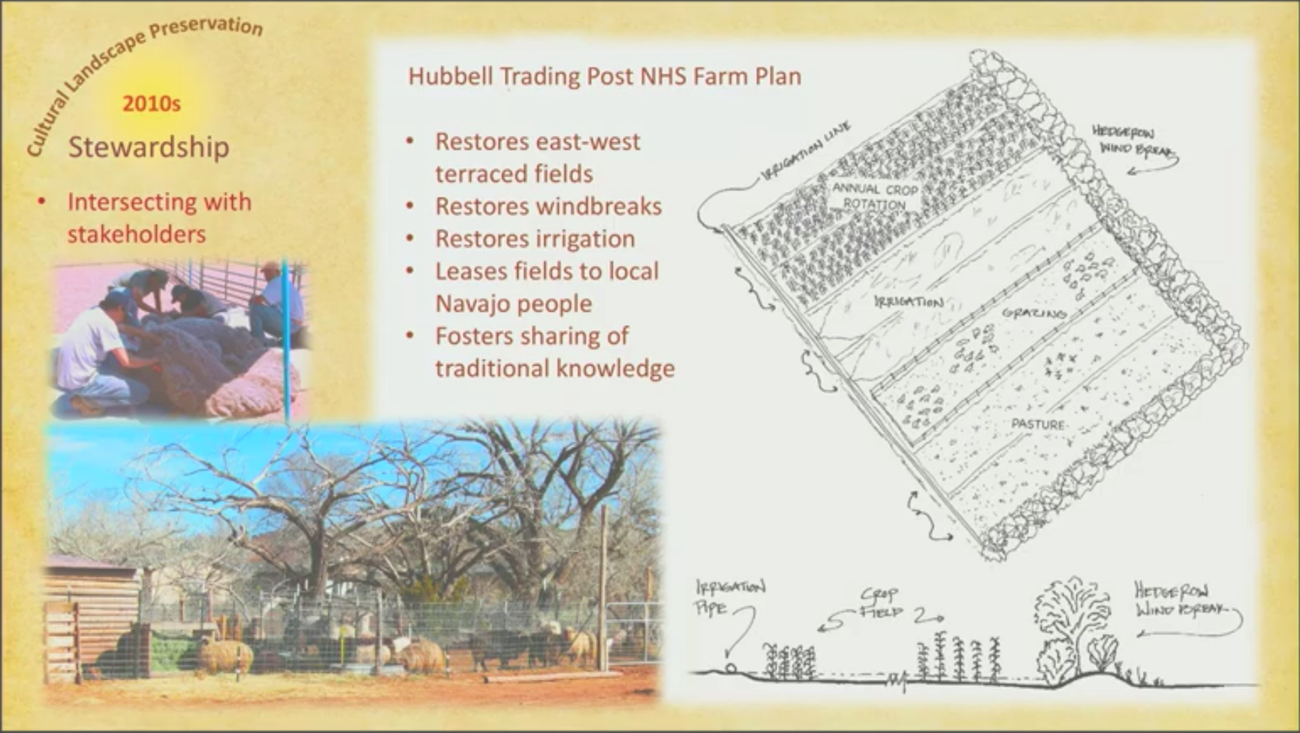
Susan Dolan, National Park Service
We're also doing more in this decade to use a diversity of maintenance methods in combination with each other such as brush hogging, controlled burning, and using grazing animals under contract, bringing in goats for instance, for hire and working these methods in concert with each other to maximize cultural landscape values and natural resource benefits too. An example of intersecting with stakeholders, and we're becoming less myopic, we're trying to become more broad in our vision, this is an example from Hubbell Trading Post National Historic Site in Arizona. Hubbell put together a farm plan using a contractor who worked very closely with the local community of Navajo people. Hubbell Trading Post is a place where John Hubbell would sell trade goods from the Navajo people in the 19th century. But he also was the conduit for goods that the Navajo people needed to being exchanged.
This place was a place of a beautiful store and a gorgeous adobe structure, but it also had farmlands around it that grew the produce that would be sold in the trading post too. These fields had disappeared. This work brought back the Navajo people to restore the fields, restore the East West terraced fields, restore wind breaks around the fields, restore the historic pattern of irrigation and provide leases to local Navajo people to farm the fields and also helping them have an opportunity to share their traditional knowledge of traditional farming techniques for this part of the world, very arid part of the world, and also the types of crops that worked well here. An idea of a project that intersected with stakeholders that brought multiple benefits for restoring the landscape, but also providing something that was relevant to the local people who had always had a vested interest here but hadn't had an opportunity up until the time of the farm plan.
In another example of intersecting with stakeholders, we go to Lyons Ranches National Historic District in Redwoods National and State Parks in California. Here we're maintaining historic meadows and sheep pasture through controlled burns in partnership with the local Yurok people. They have a vested interest here in having vegetation for traditional uses stimulated by the controlled burns, but we benefit from them from their traditional knowledge about good times to burn, when to burn, how hot and how long to burn, and all of the sophistication that comes into burning without making a big mess of it. The Yurok people bring with them traditional knowledge about how to do that.
In terms of acknowledging our constraints and opportunities, we're realizing, of course, that we can't do this all alone, that we shouldn't do this all alone, that we don't have all of the knowledge that we need, that other people have knowledge that we need. In Hawaii, on the Big Island on the Kona coast, we're working with local native Hawaiians to help bring the knowledge that we lack to do repairs. Here at Kaloko Honokohau National Historical Park, the local Hawaiian people are helping us repair this Kaloko Kuapa. It's a seawall that, historically, has been built and rebuilt and repaired and rebuilt again to create a fish pond at the ocean coastline.
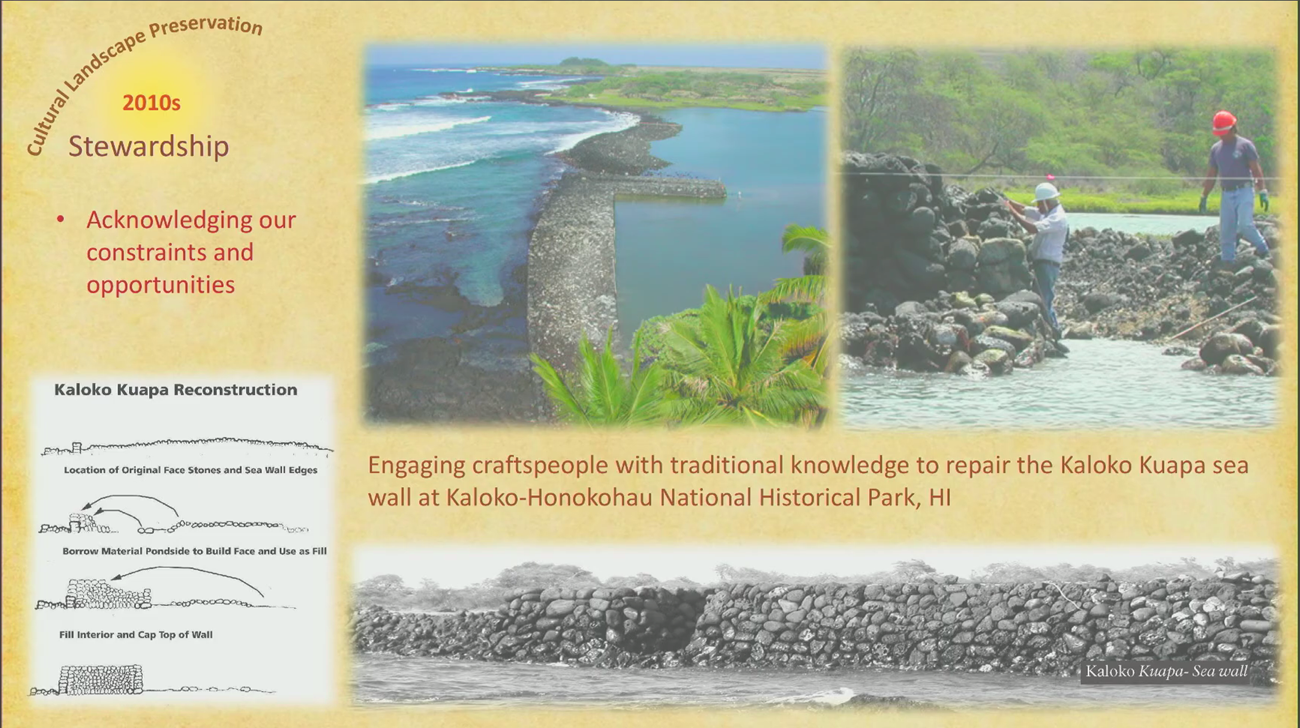
Susan Dolan, National Park Service
Seawater water comes in here, fish come in here. They get trapped, essentially, in here and held here for use. Almost like having a refrigerator, but that's a fish pond. But because this is by side the ocean, this wall is frequently damaged by storms and it always has been frequently damaged, of course, by storms and probably the impacts are greater now than ever. This particular style of masonry is not something that anyone can do. It takes tremendous skill, a dry laid form of masonry. Local people are helping us do the work, teaching youth to do the work, teaching us to do this work.
In terms of acknowledging our constraints, we're also, of course, really embracing agency wide, the impacts of climate change that are upon us. We are monitoring the condition of cultural landscapes. We keep that information in the cultural landscape inventory that we repeat periodically to update. We're documenting changes that occur. As I said yesterday, we're really trying to embrace treating for resilience to help build upon the capacity of landscapes to adapt. Once again, Robert stepped in to help us in this era and led a group to do a study on Climate Change and Cultural Landscapes in the National Park System, and he really helped us understand what vulnerability meant. That vulnerability needed to take into account the amount of exposure to climate phenomena a particular landscape is receiving, its particular sensitivity to those phenomena as a result of its inherent capacity to adapt or not. Also, our adaptive capacity to help that landscape all factored together gives us vulnerability.
Now, looking forward what's ahead of us and really in closing, thinking about looking at what's ahead. At this point, I believe the National Park Service has achieved recognition for cultural landscapes. We have the necessary legal tools we need to protect them, and that is within the limitations of politics, of course, but we have that codification, we have the professionalization, we have those tools. However, the National Park Service mission is far greater than the agency's capacity to address the mission. Our mission is the preservation of natural and cultural resources in perpetuity. Imagine that. That's a big ask, isn't it?
We have insufficient staff to manage and care for our known cultural landscapes. Currently, the known number is 860, but we continue to do inventories of potential cultural landscapes all the time and recognize, as a result of that, more and more cultural landscapes. Of course, as we move forward in time, we've recognize more things from the past as being historically significant, so that number is always going to continue to grow. I believe the concept of resilience, the ability to withstand change is inherent to varying degrees in cultural landscapes, but is also promoted by stewardship, including preservation maintenance. I'm repeating myself, I realize, but I really want to drive this point home.
Cultural landscapes are experiencing the incremental impacts of a changing climate and catastrophic impacts may be on the horizon. But I think that there are things we can do to scenario plan for catastrophic impacts, but we almost mustn't get distracted by the images of catastrophe. We need to hunker down and be grounded in what we can do today to help landscapes with the incremental change that's occurring all the time as opposed to getting freaked about the catastrophic stuff that could happen at any time.
National Park Service is not in this alone. We have federal agencies, states, tribes, communities, academic institutions, international advocates to draw upon. There are a lot of people that, in a way, we aren't a world unto ourselves. We are in this with everyone and we are preserving these resources for everyone, really, everyone in the world.
Drawing upon this capacity, we can strive to optimize the tools that we have available to attempt to preserve the cultural landscapes that we all care about. I believe the future of National Park Service cultural landscape preservation should be focused on supporting the resilience of cultural landscapes to endure by adapting to change. Here again in Hawaii, this time at Pu'ukoholā Heiau, after the tsunami of 2011, local Hawaiian people brought their skills, their traditional knowledge to help us rebuild this heiau that have been damaged by the tsunami. Again, the example that we're all in this together, National Park Service isn't the only ones that value the heiau. Visitors throughout the world aren't the only ones that are enjoying the heiau. They belonged to all of us and local people are ready to pitch in.
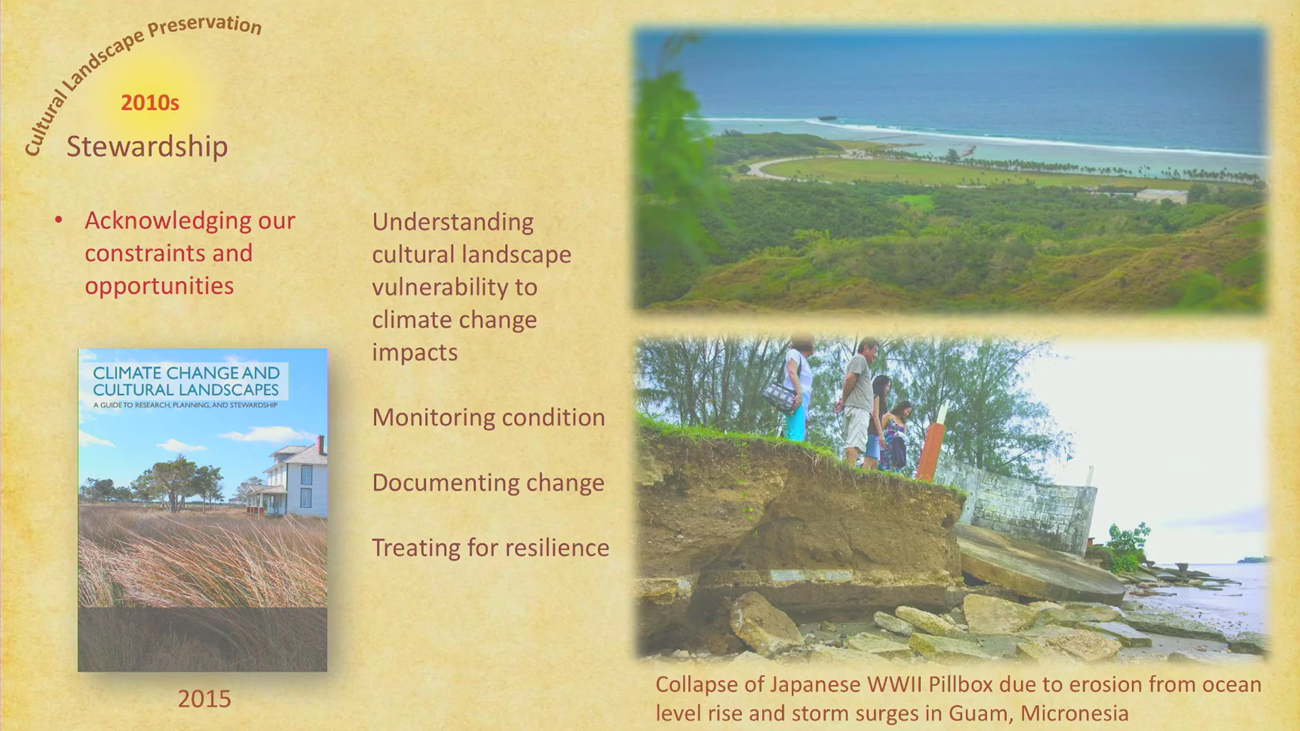
Susan Dolan, National Park Service
Culture will always have a role to play in the preservation of cultural landscapes. Culture can support natural processes that build resilience and culture provides the cultural processes that are needed to sustain landscapes. If I can leave you with one thought, it's about that cultural landscapes need culture, they need cultural input to sustain them. Cultural landscapes are borne of culture, and they must have culture to sustain them. Whether that culture is mowing, pruning, harvesting, gathering, burning or visiting, culture sustains cultural landscapes both physically and conceptually in our beliefs. Essentially.
Those landscapes that cannot be sustained physically or tangibly, if you like, can be sustained in cultural significance through other mechanisms, such as the perpetuation of traditional knowledge, historical knowledge, the perpetuation of traditional skills. We may not always be able to preserve tangibly, but we can do our utmost to preserve the intangibles together, all of us. The only way, in fact, we can lose cultural landscapes is to do nothing and ignore them. But as long as we continue to do something to document them, experience them, care for them, learn from them, treasure them, they will remain relevant to us conceptually and, therefore, they will remain cultural landscapes.
In closing, I'd like you all to feel welcome to email me if you have questions, want to find out more about National Park Service Cultural Landscapes, susan_dolan @nps.gov. We have a National Park Service website for cultural landscapes, nps.gov/culturallandscapes. We have social media, a lot of social media. You can follow us. We share stories, public newsworthy every week of the year about National Park Service Cultural Landscapes on our social media. Then, we also have a data store online, where you can download the cultural landscape inventories or reports from cultural landscapes. This is something that will be a live link in this PowerPoint, presumably, when the PowerPoint is shared, but also you can reach out to me and ask me, "Hey, what's that link for downloading documents about cultural landscapes?" Thank you very much.
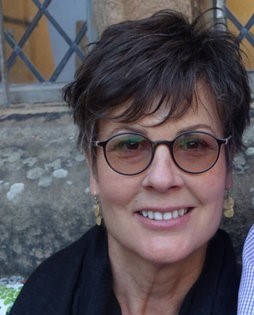
National Park Service
Speaker Biography
Susan Dolan is a Historical Landscape Architect and Manager of the U.S. Department of the Interior (USDI), National Park Service, Park Cultural Landscapes Program. Her responsibilities include developing, implementing and overseeing a service-wide landscape preservation program that includes research, planning, stewardship, education and technology development. She previously served as the Historical Landscape Architect for Mount Rainier National Park.
She has undergraduate and graduate degrees in landscape architecture from the University of Oregon and an undergraduate degree in horticulture from Reading University in England.
Publications include: “Orchard Management Plan for Manzanar National Historic Site,” United States Department of the Interior (USDI), National Park Service, Pacific West Regional Office, 2011; “Fruitful Legacy: A Historic Context of Orchards and Fruit Trees in the National Park System, from 1600 to the Present,” USDI, National Park Service, Olmsted Center for Landscape Preservation and Pacific West Regional Office, 2009, and “Orchard Management Plan for John Muir National Historic Site,” USDI, National Park Service, Pacific West Regional Office, 2006.
